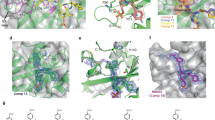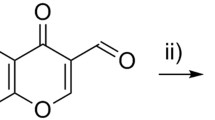Abstract
Signal transducer and activator of transcription 3 (Stat3) transmits signals from growth factors and interleukin-6 family cytokines by binding to their receptors via its Src homology 2 (SH2) domain. This results in phosphorylation of Tyr705, dimerization, translocation to the nucleus, and regulation of transcription of downstream genes. Stat3 is constitutively activated in several human cancers and is a target for anti-cancer drug design. We have shown previously phosphorylation of Tyr705 in intact cancer cells can be inhibited with prodrugs of phosphopeptide mimics targeting the SH2 domain. In a series of prodrugs consisting of bis-pivaloyloxymethyl esters of 4′-phosphonodifluoromethyl cinnamoyl-Haic-Gln-NHBn, appending methyl group to the β-position of the cinnamate increased potency ca. twofold, which paralleled the increase in affinity of the corresponding phosphopeptide models. However, dramatic increases in potency were observed when the C-terminal C(O)NHBn of Gln-NHBn was replaced with a simple methyl group. In this communication we continue to explore the effects of structural modifications of prodrugs on their ability to inhibit Tyr705 phosphorylation. A set of 4-substituted prolines incorporated into β-methyl-4-phosphocinnamoyl-leucinyl-Xaa-4-aminopentamide model peptides exhibited affinities of 88–317 nM by fluorescence polarization (Pro IC50 = 156 nM). In corresponding prodrugs, Pro inhibited constitutive Stat3 phosphorylation at 10 μM in MDA-MB-468 breast tumor cells. However, 4,4-difluoroproline and 4,4-dimethylproline resulted in complete inhibition at 0.5 μM. These results suggest that the prodrug with native proline undergoes metabolism that those with substituted prolines do not. In conclusion, changes in structure with minimal impact on intrinsic affinity can nevertheless have profound effects on the cellular potency of prodrug inhibitors of Stat3.






Similar content being viewed by others
Abbreviations
- 4,4-Me2Pro:
-
4,4-Dimethylproline
- 4,4-F2Pro:
-
4,4-Difluoroproline
- 4-FPro:
-
4-Fluoroproline
- 4-HOPro:
-
4-Hydroxyproline
- 4-MeOPro:
-
4-Methoxyoxyproline
- Apa:
-
(R)-4-Aminopentamide
- DIEA:
-
Diisopropylethylamine
- DIC:
-
Diisopropylcarbodiimide
- Haic:
-
5-(Amino)-1,2,4,5,6,7-hexahydro-4-oxo-(2S,5S)-azepino[3,2,1-hi]indole-2-carboxylic acid
- HOBt:
-
1-Hydroxybenzotriazole
- IL-6:
-
Interleukin-6
- JAK:
-
Janus kinase
- mPro:
-
cis-3,4-Methanoproline
- pCinn:
-
4-Phosphoryloxycinnamide
- βMpCinn:
-
β-Methyl pCinn or [2E] 3-(4-phosphoryloxyphenyl)-2-butenamide
- POM:
-
Pivaloyloxymethyl
- pStat3:
-
Tyr705 phosphorylated Stat3
- PyBOP:
-
1H-Benzotriazol-1-yloxytripyrrolidinophosphonium hexafluorophosphate
- SH2 domain:
-
Src homology 2 domain
- Stat3:
-
Signal transducer and activator of transcription 3
- TFA:
-
Trifluoroacetic acid
- TIS:
-
Triisopropylsilane
References
Akira S, Nishio Y, Inoue M, Wang XJ, Wei S, Matsusaka T, Yoshida K, Sudo T, Naruto M, Kishimoto T (1994) Molecular cloning of APRF, a novel IFN-stimulated gene factor 3 p91-related transcription factor involved in the gp130-mediated signaling pathway. Cell 77:63–71
Becker S, Groner B, Muller CW (1998) Three-dimensional structure of the Stat3beta homodimer bound to DNA. Nature 394:145–151
Burke TR Jr, Smyth MS, Otaka A, Nomizu M, Roller PP, Wolf G, Case R, Shoelson SE (1994) Nonhydrolyzable phosphotyrosyl mimetics for the preparation of phosphatase-resistant SH2 domain inhibitors. Biochemistry 33:6490–6494
Chen J, Nikolovska-Coleska Z, Yang CY, Gomez C, Gao W, Krajewski K, Jiang S, Roller P, Wang S (2007) Design and synthesis of a new, conformationally constrained, macrocyclic small-molecule inhibitor of STAT3 via ‘click chemistry’. Bioorg Med Chem Lett 17:3939–3942
Chen J, Bai L, Bernard D, Nikolovska-Coleska Z, Gomez C, Zhang J, Yi H, Wang S (2010) Structure-based design of conformationally constrained, cell-permeable STAT3 inhibitors. ACS Med Chem Lett 1:85–89
Chiang YC, Lin YJ, Horng JC (2009) Stereoelectronic effects on the transition barrier of polyproline conformational interconversion. Protein Sci 18:1967–1977
Chiba J, Takayama G, Takashi T, Yokoyama M, Nakayama A, Baldwin JJ, McDonald E, Moriarty KJ, Sarko CR, Saionz KW, Swanson R, Hussain Z, Wong A, Machinaga N (2006) Synthesis, biological evaluation, and pharmacokinetic study of prolyl-1-piperazinylacetic acid and prolyl-4-piperidinylacetic acid derivatives as VLA-4 antagonists. Bioorg Med Chem 14:2725–2746
Coleman DR IV, Ren Z, Mandal PK, Cameron AG, Dyer GA, Muranjan S, Campbell M, Chen X, McMurray JS (2005) Investigation of the binding determinants of phosphopeptides targeted to the SRC homology 2 domain of the signal transducer and activator of transcription 3. Development of a high-affinity peptide inhibitor. J Med Chem 48:6661–6670
Coleman DR IV, Kaluarachchi K, Ren Z, Chen X, McMurray JS (2008) Solid phase synthesis of phosphopeptides incorporating 2,2-dimethyloxazolidine pseudoproline analogs: evidence for trans Leu-Pro peptide bonds in Stat3 inhibitors. Int J Pept Res Ther 14:1–9
Darnell JE Jr (2002) Transcription factors as targets for cancer therapy. Nat. Rev. Cancer 2:740–749
Demange L, Menez A, Dugave C (1998) Practical synthesis of Boc and Fmoc protected 4-fluoro and 4-difluoroprolines from trans-4-hydroxyproline. Tetrahedron Lett 39:1169–1172
Ezquerra J, Pedregal C, Rubio A, Vaquero JJ, Matia MP, Martin J, Diaz A, Navio JLG, Deeter JB (1994) Stereoselective double alkylation of ethyl N-boc-pyroglutamate. J Org Chem 59:4327–4331
Farquhar D, Khan S, Srivastva DN, Saunders PP (1994) Synthesis and antitumor evaluation of bis[(pivaloyloxy)methyl] 2′-deoxy-5-fluorouridine 5′-monophosphate (FdUMP): a strategy to introduce nucleotides into cells. J Med Chem 37:3902–3909
Fletcher S, Turkson J, Gunning PT (2008) Molecular approaches towards the inhibition of the signal transducer and activator of transcription 3 (Stat3) protein. ChemMedChem 3:1159–1168
Fletcher S, Singh J, Zhang X, Yue P, Page BD, Sharmeen S, Shahani VM, Zhao W, Schimmer AD, Turkson J, Gunning PT (2009) Disruption of transcriptionally active Stat3 dimers with non-phosphorylated, salicylic acid-based small molecules: potent in vitro and tumor cell activities. ChemBioChem 10:1959–1964
Gunning PT, Katt WP, Glenn M, Siddiquee K, Kim JS, Jove R, Sebti SM, Turkson J, Hamilton AD (2007) Isoform selective inhibition of STAT1 or STAT3 homo-dimerization via peptidomimetic probes: structural recognition of STAT SH2 domains. Bioorg Med Chem Lett 17:1875–1878
Gunning PT, Glenn MP, Siddiquee KA, Katt WP, Masson E, Sebti SM, Turkson J, Hamilton AD (2008) Targeting protein–protein interactions: suppression of Stat3 dimerization with rationally designed small-molecule, nonpeptidic SH2 domain binders. ChemBioChem 9:2800–2803
Hecker SJ, Erion MD (2008) Prodrugs of phosphates and phosphonates. J Med Chem 51:2328–2345
Hedvat M, Huszar D, Herrmann A, Gozgit JM, Schroeder A, Sheehy A, Buettner R, Proia D, Kowolik CM, Xin H, Armstrong B, Bebernitz G, Weng S, Wang L, Ye M, McEachern K, Chen H, Morosini D, Bell K, Alimzhanov M, Ioannidis S, McCoon P, Cao ZA, Yu H, Jove R, Zinda M (2009) The JAK2 inhibitor AZD1480 potently blocks Stat3 signaling and oncogenesis in solid tumors. Cancer Cell 16:487–497
Kreis S, Munz GA, Haan S, Heinrich PC, Behrmann I (2007) Cell density dependent increase of constitutive signal transducers and activators of transcription 3 activity in melanoma cells is mediated by Janus kinases. Mol Cancer Res 5:1331–1341
Krise JP, Stella VJ (1996) Prodrugs of phosphates, phosphonates, and phosphinates. Adv Drug Deliv Rev 19:287–310
Levy DE, Darnell JE Jr (2002) Stats: transcriptional control and biological impact. Nat Rev Mol Cell Biol 3:651–662
Looyenga BD, Hutchings D, Cherni I, Kingsley C, Weiss GJ, Mackeigan JP (2012) STAT3 is activated by JAK2 independent of key oncogenic driver mutations in non-small cell lung carcinoma. PLoS One 7:e30820
Mandal PK, Heard PA, Ren Z, Chen X, McMurray JS (2007) Solid-phase synthesis of Stat3 inhibitors incorporating O-carbamoylserine and O-carbamoylthreonine as glutamine mimics. Bioorg Med Chem Lett 17:654–656
Mandal PK, Liao WS, McMurray JS (2009a) Synthesis of phosphatase-stable, cell-permeable peptidomimetic prodrugs that target the SH2 domain of Stat3. Org Lett 11:3394–3397
Mandal PK, Limbrick D, Coleman DR, Dyer GA, Ren Z, Birtwistle JS, Xiong C, Chen X, Briggs JM, McMurray JS (2009b) Conformationally constrained peptidomimetic inhibitors of signal transducer and activator of transcription 3: evaluation and molecular modeling. J Med Chem 52:2429–2442
Mandal PK, Ren Z, Chen X, Xiong C, McMurray JS (2009c) Structure-affinity relationships of glutamine mimics incorporated into phosphopeptides targeted to the SH2 domain of signal transducer and activator of transcription 3. J Med Chem 52:6126–6141
Mandal PK, Gao F, Lu Z, Ren Z, Ramesh R, Birtwistle JS, Kaluarachchi KK, Chen X, Bast RC, Liao WS, McMurray JS (2011) Potent and Selective phosphopeptide mimetic prodrugs targeted to the Src homology 2 (SH2) domain of signal transducer and activator of transcription 3. J Med Chem 54:3549–5463
McMurray JS (2008) Structural basis for the binding of high affinity phosphopeptides to Stat3. Biopolymers 90:69–79
Pearson DA, Blanchette M, Baker ML, Guindon CA (1989) Trialkylsilanes as scavengers for the trifluoroacetic acid deblocking of protecting groups in peptide synthesis. Tetrahedron Lett 30:2739–2742
Ren Z, Cabell LA, Schaefer TS, McMurray JS (2003) Identification of a high-affinity phosphopeptide inhibitor of Stat3. Bioorg Med Chem Lett 13:633–636
Sagnard I, Sasaki NA, Chiaroni A, Riche C, Potier P (1995) Enantioselective synthesis of cyclopropane a-amino acids: synthesis of N-Boc-cis. (2S,3R,4S)-3,4-methanoproline and N-Boc-(2S,3R,4S)-3,4-methanoglutamic acid. Tetrahedron Lett 36:3149–3152
Schultz C (2003) Prodrugs of biologically active phosphate esters. Bioorg Med Chem 11:885–898
Shahani VM, Yue P, Fletcher S, Sharmeen S, Sukhai MA, Luu DP, Zhang X, Sun H, Zhao W, Schimmer AD, Turkson J, Gunning PT (2011a) Design, synthesis, and in vitro characterization of novel hybrid peptidomimetic inhibitors of STAT3 protein. Bioorg Med Chem 19:1823–1838
Shahani VM, Yue P, Haftchenary S, Zhao W, Lukkarila JL, Zhang X, Ball D, Nona C, Gunning PT, Turkson J (2011b) Identification of purine-scaffold small-molecule inhibitors of Stat3 activation by QSAR studies. ACS Med Chem Lett 2:79–84
Siddiquee KA, Gunning PT, Glenn M, Katt WP, Zhang S, Schrock C, Sebti SM, Jove R, Hamilton AD, Turkson J (2007) An oxazole-based small-molecule Stat3 inhibitor modulates Stat3 stability and processing and induces antitumor cell effects. ACS Chem Biol 2:787–798
Stahl N, Farruggella TJ, Boulton TG, Zhong Z, Darnell JE Jr, Yancopoulos GD (1995) Choice of STATs and other substrates specified by modular tyrosine-based motifs in cytokine receptors. Science 267:1349–1353
Turkson J, Kim JS, Zhang S, Yuan J, Huang M, Glenn M, Haura E, Sebti S, Hamilton AD, Jove R (2004) Novel peptidomimetic inhibitors of signal transducer and activator of transcription 3 dimerization and biological activity. Mol Cancer Ther 3:261–269
Witkop B, Fujimoto Y, Irreverre F, Karle JM, Karle IL (1971) Synthesis and x-ray analysis of cis-3,4-methylene-l-proline, the new natural amino acid from horse chestnuts, and of its trans isomer. J Am Chem Soc 93:3471–3477
Yu H, Jove R (2004) The STATs of cancer—new molecular targets come of age. Nat Rev Cancer 4:97–105
Zhang X, Yue P, Fletcher S, Zhao W, Gunning PT, Turkson J (2010) A novel small-molecule disrupts Stat3 SH2 domain-phosphotyrosine interactions and Stat3-dependent tumor processes. Biochem Pharmacol 79:1398–1409
Acknowledgments
We are grateful to the National Cancer Institute (CA096652) for support of this work. Partial support by a Grant from the Center for Targeted Therapy of The University of Texas M. D. Anderson Cancer Center and the Texas Institute of Drug and Diagnostic Development at The University of Texas at Austin is acknowledged. We also acknowledge the NCI Cancer Center Support Grant CA016672 for the support of both our NMR facility and the Translation Chemistry Core Facility which performed the mass spectrometry. Funding as an Odyssey Fellow (Z.R.) was supported by the Odyssey Program and the Cockrell Foundation Award for Scientific Achievement at UTMDACC.
Conflict of interest
The authors have no association with commercial entities associated with this work.
Author information
Authors and Affiliations
Corresponding author
Electronic supplementary material
Below is the link to the electronic supplementary material.
Rights and permissions
About this article
Cite this article
Mandal, P.K., Ren, Z., Chen, X. et al. Structure–Activity Studies of Phosphopeptidomimetic Prodrugs Targeting the Src Homology 2 (SH2) Domain of Signal Transducer and Activator of Transcription 3 (Stat3). Int J Pept Res Ther 19, 3–12 (2013). https://doi.org/10.1007/s10989-012-9313-0
Accepted:
Published:
Issue Date:
DOI: https://doi.org/10.1007/s10989-012-9313-0




